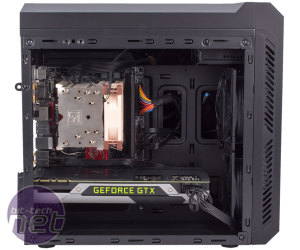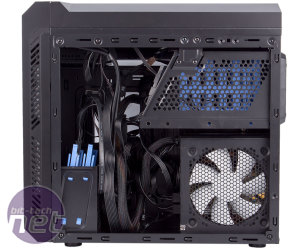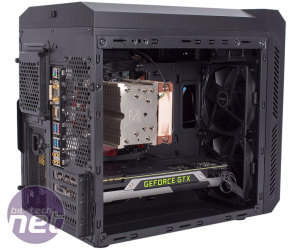
Performance Analysis
With a delta T of 54°C at full speed, the Antec P50 has a mid-league result, which is what's to be expected from a case with good intake but limited exhaust capabilities. An exhaust fan would definitely improve matters, as the result for the Raijintek Styx with its fans reversed shows. In this setup, the Styx has very good intake and exhaust airflow and is 6°C cooler as a result.That said, note that the P50 is better than the Phanteks Enthoo EVOLV ITX by a whole 11°C. There are a number of likely reasons for this: the P50 has better intake airflow (two fans over one) and is smaller, making that airflow more concentrated. It also has built-in roof ventilation, which the Phanteks case doesn't, and this gives hot air a natural place to leave the chassis. Further confirmation that this roof ventilation really does make a big difference comes from the fact that even with the front fans disabled completely, the CPU temperature in the P50 climbs only by 3°C, which still puts it at 8°C better than the Phanteks case.
The GPU cooling, meanwhile, is on par with the Phanteks chassis, which again makes sense as they have a fairly similar setup: an intake fan right next to the GPU but no additional ventilation beneath it. You can see how much the GPU relies on the front intakes as reducing the fan speed has a much greater impact than with the CPU: 5°C more moving to low speed and a further 5°C when they're off altogether.
In terms of fan noise, there's a clear difference between the high and low settings, but you'd have to have very quiet internal hardware to hear a big change between low speed and off completely, as the low speed setting is extremely quiet. Pleasingly, the 80mm fan, which we did connect for testing, is not that noisy either. Most systems would be okay on low speed, but we'd probably switch to high when gaming in a high-end system to prevent our graphics card from spinning up too much.
Conclusion
Overall, we're pretty impressed with the P50. For the money, it's a nice design that's easy to work with. It's got a really impressive set of features too and while it may not be as fancy or quite as water-cooling friendly as the Corsair Carbide Air 240, it's £30 less expensive and the benefits of a dual chamber design, such as a clean-looking build, easy cable routing and a direct airflow path are maintained for the most part. Some rubber grommets would definitely be nice but even so this is a great little sub-£50 chassis.
-
Cooling21 / 30
-
Features18 / 20
-
Design25 / 30
-
Value19 / 20


MSI MPG Velox 100R Chassis Review
October 14 2021 | 15:04












Want to comment? Please log in.